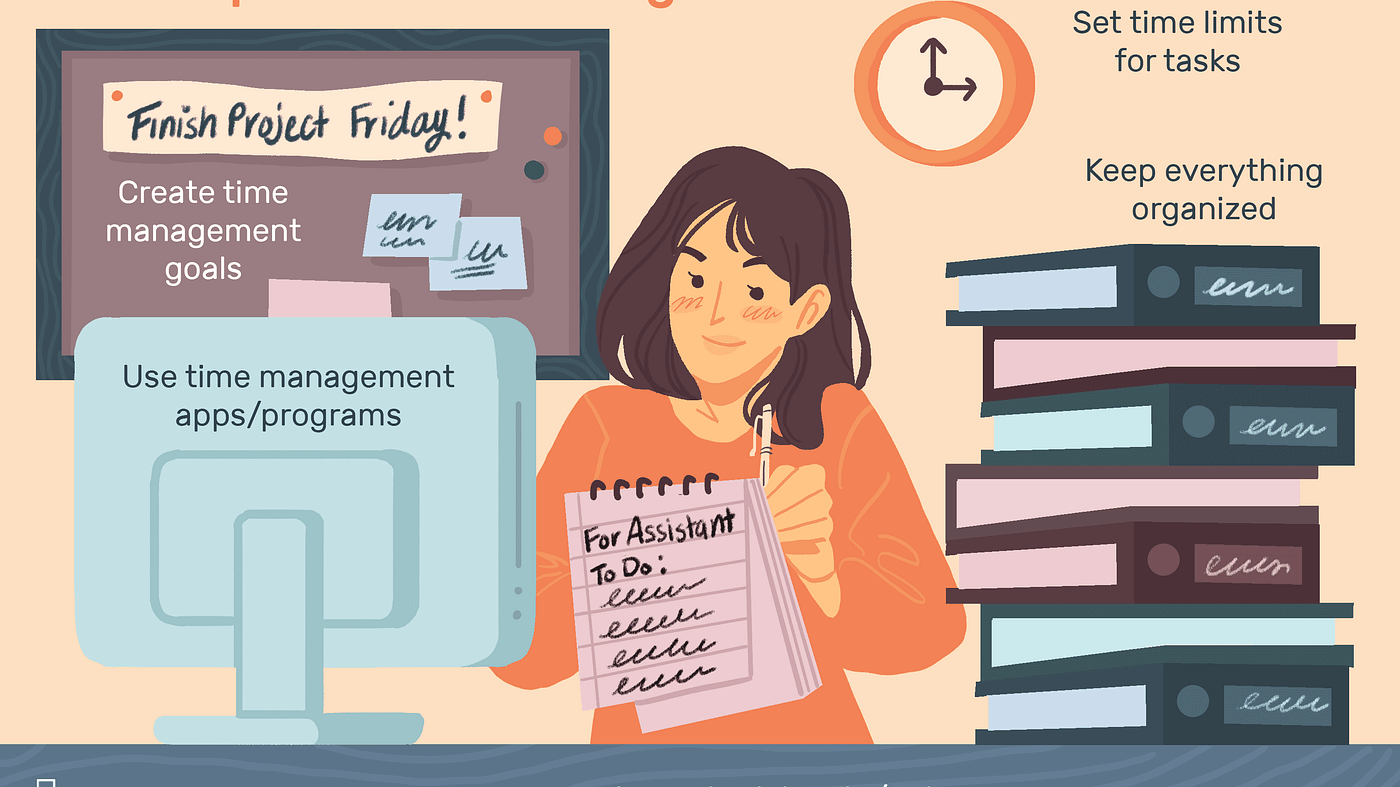11 Best Time Management Techniques to Ace your Next Task

- Set a timer and concentrate on only one task for 25 minutes. Keep away from email, social media, or news outlets at this time.
- After 25 minutes, take a 5- to 10-minute break and mark off one pomodoro (interval).
- After completing three pomodoros, take a lengthier interval of 20-30 minutes.
- Start over.
- Use either project management software or pen and paper.
- Create three columns for your tasks. These columns will represent the different stages of your project’s development. You can add more columns and customize the principles to fit your own needs.
- List all your backlogs or tasks in the first column. You then decide what tasks you're supposed to move to the To-Do column, and what tasks can wait their turn.
- 2nd column: To-Do - these are the tasks you'll work on
- 3rd column: In Progress - tasks you are currently working on
- 4th column: Done - tasks you've finished
- List down all your activities, tasks, and goals.
- Allocate a longer period for the tasks you want to prioritize and focus on.
- If it's a difficult task, parse it, and allocate a shorter time (for example, 20-30 minutes) to parts of it in order to make the task easier to manage.
- Set your timer.
- Begin with your first activity, and accomplish the following tasks
- When the timer beeps, stop working on it.
- Take a break.
- Review what you've managed to accomplish.
- Proceed to the other time boxes
With time blocking, you can comprehensively keep track of your workday. You arrange your day into time blocks that are allocated to doing certain tasks. The idea is to look ahead at your week's tasks and get a sense of what's coming up. Then, for each work, set out time periods. Each day, when new activities arrive, you may alter the time blocks. This technique has been made popular by Elon Musk.
How it works:
- Define you tasks and activities; identify priorities.
- Assign each task with a specific time block - number of minutes or hours depending on the priority level of the task, with specific days, beginning and end times noted in your calendar.
- Note everything in a calendar: the day, the start time, and the end time.
- Start working on the first daily task and proceed your way down.
- Schedule breaks between time blocks.
With this strategy, you won't have to waste your time making decisions about what to work on today or tomorrow. Therefore, you can make better use of your time rather than getting distracted.
Using a system of lists, reminders, and frequent reviews, the GTD technique promotes increased productivity. Because activities are structured and prioritized, this strategy can surely reduce your stress.
How it Works
- Collect all of the duties that come to mind.
- Determine whether or not the work can be completed. If that's the case, decide what you'll do next. Otherwise, put it on hold.
- Place everything in its proper place. This entails marking events on your calendar, assigning activities to others, storing reference materials for later use, and organizing your tasks.
- Make sure your lists are up to date.
- Make confident decisions on what to do next by using the same system.
How it Works
To reach inbox zero, you have to:
- Decide what time of the day you'll work on your inbox management and stick to it.
- Turn off notifications and close the email tab in your browser.
- Make a list of your most important emails.
- Respond to the most important emails as soon as possible.
- Emails that will take you longer to respond to should be moved to a "needs a response" folder.
- Delete and archive outdated or unwanted messages.
Eat the Frog is a time management technique that allows you to prioritize the most important work first – the work most of us are likely to avoid.
How it Works? Simple, get started on the most mind-grueling task first thing in the morning, and you’ll have a feeling of accomplishment for the rest of the day. The early hours of the day are the times when you feel most refreshed and focused. Hence, it will be much easier to work on them.
How it Works:
List all your tasks, and divide them into 4 parts
- The 1st quadrant - Tasks that you should do immediately (important AND urgent).
- The 2nd quadrant - Tasks that are important, but are not on the rush. You should make a plan when you'll tackle them.
- The 3rd quadrant - Tasks that are not important, but are urgent. You should delegate these tasks to your colleagues.
- The 4th quadrant - Tasks that are not important and not urgent. You should remove them from your schedule.
Jerry Seinfeld's productivity remark "Don't break the chain" is said to have inspired a specific calendar method. In this technique, you mark each workday with red, forming a chain of "red" days. If you missed a day of working, you don't mark it red; thus, you "break the chain."
How it Works:
- Get a red marker and a big calendar.
- Each day you work, even for a short period, mark that day with the red marker.
- A chain of “red” days will be formed once you work continuously every day.
- If you stopped working, don't mark that day with red, and you "break the chain."
This strategy is as simple as it gets. You set a timer for 10 minutes to work on a task. After the ten minutes are over, you must decide whether to stop or continue. This is because parsing your work into small chunks of time will help you gain a sense of momentum, and you don't feel too overwhelmed when you work for only 10 minutes at a time.
How it Works:
- Select a task.
- Start working on it immediately.
- When the 10 minutes is over, ask this question: do I want to stop working on the task, or do I want to continue for 10 minutes more?
- Work for 10-minute time periods until you want to stop working on this task for the day.
This next time management technique is perfect for procrastinators and those who work well under pressure. The phrase "work expands to fill the time available for its completion," introduced by British historian Cyril Northcote Parkinson, means that the amount of time you give yourself to perform a task is the amount of time it will take you to finish that very task.
How it Works
Try these in your next assignment:
- Try working without a computer charger. This will force you to finish a project before your computer shuts down.
- Get it done early. Start your assignment in the morning and finish it by noon.
- Set a deadline. As much as possible, set a deadline earlier than the actual due date.
- Limit time for tasks. Allocate a specific number of minutes or hours for a task. Set a timer.
Mastering time management will help people from different walks of life succeed. Figuring out what strategy fits you will certainly usher in skyrocketing results. So if you want a better you this 2022, these time management techniques are the real game-changers!
